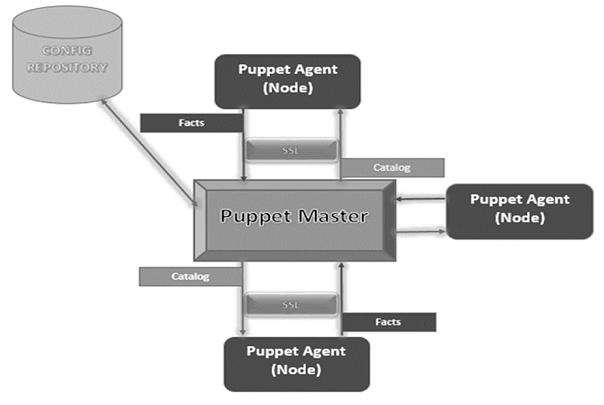
Puppet is an open-source software configuration management tool. It keeps running on numerous Unix-like systems and additionally on Microsoft Windows, and incorporates its own revelatory language to describe system configuration. Puppet created by Puppet, established by Luke Kanies in 2005. It written in Ruby and released as free programming under the GNU General Public License (GPL) until rendition 2.7.0 and the Apache License 2.0 after that.
Get in touch with OnlineITGuru for mastering the Devops Online Training
Puppet gives you a programmed approach to review, convey, work and future-verification the majority of your product, regardless of where it runs. With the Puppet approach, you realize what you have so you can control and implement consistency crosswise over it, secure it and keep it agreeable, at the same time modernizing it as business needs direct. You can describe what you need your applications and foundation to look like utilizing a typical simple to-read language. From that point you can share, test and enforce the changes you need to make over your data center and cloud platforms.
Puppet master: It also called MOM of Masters (Mom) the focal center point of action and process in Puppet Enterprise. This is the place where Puppet code is accumulated to make specialist indexes, and where SSL certifications are checked and marked.
You can installPE in one of two ways:monolithic or split. In a monolithic establishment, the MoM has all services on one hub. For a split establishment, the administrations identified with the MoM, the PE comfort, and PuppetDB (with PostgreSQL)each facilitated on partitioned hubs.
Despite the installation architecture, the MoM dependably contains an compile master and a Puppet Server. As your installation develops, you can add extra compile masters to dispense the inventory compilation workload.
Puppet Agent: Specifically Puppet Agents are the real working machines which are overseen by the Puppet master. They have the Puppet agent daemon service running inside them.Intermittently, Puppet specialist will send realities to the master and request an catalog. As a matter of fact, master arranges the catalog utilizing a few wellsprings of data, and returns the catalog to the agent Config.
Especially When it gets an index, Puppet specialist applies it by checking every asset the list depicts. On the off chance that it finds any assets that are not in their coveted state, it will roll out any improvements important to adjust them.
||{"title":"Master in DevOps ","subTitle":"DevOps by ITGURU's","btnTitle":"View Details","url":"https://onlineitguru.com/devops-course","boxType":"reg"}||
Repository: Puppet keeps up official bundle archives for a several operating systems and distributions. To make the repositories more predictable. We form them as "puppet Collections" — every gathering has the majority of the software you have to run an utilitarian Puppet deployment. In version that known to function admirably with each other. Every group is pick in, and you should pick one to install softwares and get updates.
Catalog: To design an managed hub, Puppet specialist utilizes an archive called an catalog, which it downloads from the MoM or compile master. Catalog describes desired state for every asset that ought to be overseen on the hub. And it specify dependency data for assets that ought to overseen in a specific request.
Facter : In particular Facter is Puppet's cross-stage system profiling library. It finds and reports per-hub facts , which are accessible in your Puppet shows as factors. Before requesting for an index, Puppet operator utilizes Facter to gather system data about the machine it's running on. On the basis of facts , changes done on any target machine. There characterized and custom realities in Puppet.
Characteristics:
Generally Puppet is easily adaptable. Since it is open source, custom libraries and modules can apply to suit needs.
Especially Takes care of the host for the duration of its life cycle from begin to end. Including the underlying setup, establishment, up-gradation and maintenance activities.
Computerizes monotonous errands.
Reuses resources across different platforms.
Recommended audience: Software Developer System Admins Who has exposure to automation
Prerequisites:
DevOps, get started by understanding its principles and tools you need to learn to implement them. It’s a bit easy for CS background people to pick up when compared to other branches. But anyone can master it with proper learning and training. Get in touch with OnlineITGuru for mastering the Devops Online course
